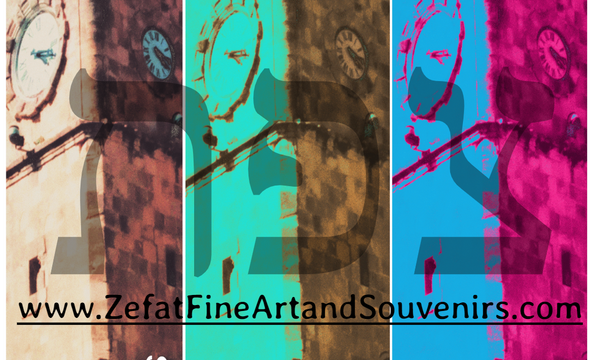Zefat Sarayah Building Art Gallery






I have done several projects with images of the Sarayah 'building because of it's; historical significance, local landmark status, ol and the unique architecture.
I have found that the use of color filters brings out minor gradations in the stonework. It has been hypothesized that the color gradients may reflect the age of the stonework in different parts of the exterior walls, including periods of renovation of the structure.
I used two images of the Sarayah Building; the clocktower and the small tower. They are available as prints, and printed on merchandise.
A BRIEF HISTORY
The Saraya Building in צפת (Zefat, Safed, Tsfas, Tzfat, and other English spellings) is one of several building with the same name. throughout the former Ottoman Empire. They served as accomodations for traveling government officials. The word 'Sarayah' means 'palace' in the Ottoman language.
The white-stone building sits on top of the hill over Aliyah Bet Street.
It was built at the beginning of the 18th century by Zahir Al Omar, a powerful Bedouin Sheikh, who controlled the Galilee. He built it as a magnificent home for himself and his family. in late Eighteenth Century Ottoman Empire, who controlled the region from 1517 to 1917 captured the Saraya. From that time until today it has served Municipal purposes. It remained an Ottoman Government building until the collapse of their empire and the start of the British mandate. At the end of the 19th century, it was renovated by the Ottoman government. At the beginning of the 20h century, the clock tower, which still stands today, was built in honor of Ebid El Haamid II, the Ottoman Sultan.
After of World War I, during British-Mandate-Palestine, the Saraya became the headquarters of British administration in northern Mandatory-Palestine.
During the riots of 1929, the British held the Jews there to protect them from the Arabs, although some were killed from sniper bullets while taking refuge there. For three days, the Jews huddled in fear while the Arabs plundered the Old City.
The British wanted to evacuate the Jews from Safed, but the Jews refused to leave and soon forced their way past the British guards and returned to the rubble of their destroyed homes. After the British withdrew and just before the War of Independence, the Saraya became the Arab leader's seat of government.
On January 4, 1948, a historic day for the city of Safed, Lehi fighters managed to blow up the building. By doing so, they were able to break the link in the Arab chain of command. After the War of Independence the Saraya was rebuilt. It had many functions over time. Such as, a regional IDF headquarters. a military hospital and an old aged home.
In 1975, the Saraya was restored again, thanks to the financial benevolence of Sir Isaac Wolfson and his wife Edith. They were prominent philanthropist and benefactors to The State of Israel. The building was then renamed “The Isaac and Edith Wolfson Community Center.”
Today, the Wolfson Community Center serves as home of the Noam synagogue, a music conservatory, and other public benefit purposes. Most recently, the bell on the clock-tower was restored.

Zefat Art
Magreb Shul ruins 19th century
Pair text with an image to focus on your chosen product, collection, or blog post. Add details on availability, style, or even provide a review.
Caption
Row
Pair text with an image to focus on your chosen product, collection, or blog post. Add details on availability, style, or even provide a review.
Caption
Row
Pair text with an image to focus on your chosen product, collection, or blog post. Add details on availability, style, or even provide a review.
